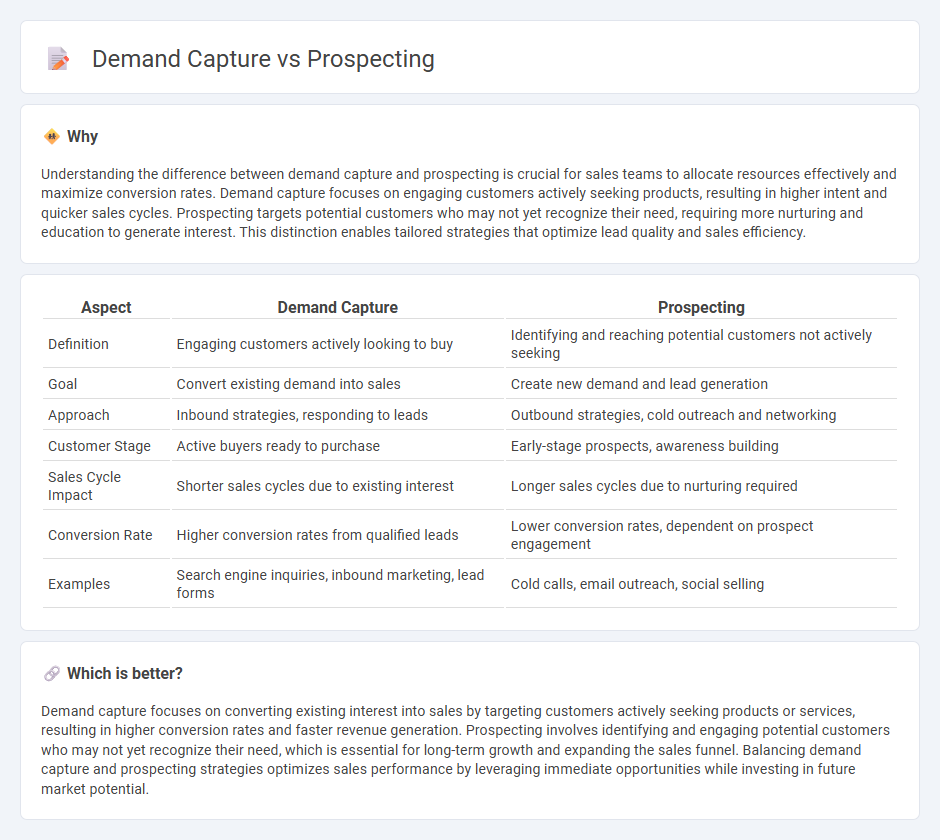
Demand capture focuses on converting existing buyer intent into sales by targeting prospects actively searching for solutions, leveraging techniques like paid search and retargeting ads to maximize conversion rates. Prospecting involves identifying and reaching out to potential customers who may not yet be aware of their needs or your product, using strategies such as cold calling, social selling, and email outreach to build a qualified pipeline. Explore more to understand how combining demand capture with effective prospecting drives revenue growth.
Why it is important
Understanding the difference between demand capture and prospecting is crucial for sales teams to allocate resources effectively and maximize conversion rates. Demand capture focuses on engaging customers actively seeking products, resulting in higher intent and quicker sales cycles. Prospecting targets potential customers who may not yet recognize their need, requiring more nurturing and education to generate interest. This distinction enables tailored strategies that optimize lead quality and sales efficiency.
Comparison Table
| Aspect | Demand Capture | Prospecting |
|---|---|---|
| Definition | Engaging customers actively looking to buy | Identifying and reaching potential customers not actively seeking |
| Goal | Convert existing demand into sales | Create new demand and lead generation |
| Approach | Inbound strategies, responding to leads | Outbound strategies, cold outreach and networking |
| Customer Stage | Active buyers ready to purchase | Early-stage prospects, awareness building |
| Sales Cycle Impact | Shorter sales cycles due to existing interest | Longer sales cycles due to nurturing required |
| Conversion Rate | Higher conversion rates from qualified leads | Lower conversion rates, dependent on prospect engagement |
| Examples | Search engine inquiries, inbound marketing, lead forms | Cold calls, email outreach, social selling |
Which is better?
Demand capture focuses on converting existing interest into sales by targeting customers actively seeking products or services, resulting in higher conversion rates and faster revenue generation. Prospecting involves identifying and engaging potential customers who may not yet recognize their need, which is essential for long-term growth and expanding the sales funnel. Balancing demand capture and prospecting strategies optimizes sales performance by leveraging immediate opportunities while investing in future market potential.
Connection
Demand capture and prospecting are interconnected processes essential for driving sales growth by identifying and engaging potential customers actively seeking solutions. Effective demand capture leverages data analytics and targeted marketing to attract qualified leads, which prospecting teams then nurture through personalized outreach and relationship-building strategies. This seamless integration optimizes the sales funnel, increasing conversion rates and accelerating revenue generation.
Key Terms
**Prospecting:**
Prospecting targets new potential customers by identifying and engaging leads who have not yet expressed interest in a product or service, often using data-driven strategies like social media outreach and cold emailing. It emphasizes building brand awareness and generating demand among untapped audiences, leveraging advanced analytics and CRM tools to optimize lead quality and conversion rates. Explore more to understand how prospecting can drive sustainable growth in competitive markets.
Lead Generation
Prospecting targets potential customers through outbound strategies like cold calling, email campaigns, and social media outreach to generate new leads. Demand capture focuses on inbound tactics, leveraging search engine optimization (SEO), pay-per-click (PPC) ads, and content marketing to attract actively searching prospects. Explore comprehensive approaches to optimize lead generation by balancing prospecting and demand capture techniques.
Outreach
Prospecting targets potential customers by identifying and engaging leads who have not yet expressed interest, using outreach techniques like cold emails and calls to generate new opportunities. Demand capture focuses on engaging prospects already searching for solutions, leveraging outreach through personalized messaging and timely responses to convert intent into action. Explore effective outreach strategies to balance prospecting and demand capture for optimal growth.
Source and External Links
What is Prospecting? Definition, Methods and Steps | Indeed.com - Prospecting is a key sales process step involving researching, prioritizing, preparing outreach, contacting potential customers, and evaluating results to uncover new business opportunities and warm up cold leads.
What is Prospecting? 6 Steps to Ensure Success | Pipedrive - Prospecting in sales means identifying and reaching out to potential customers through inbound (warm leads) and outbound (cold outreach) strategies to build trust and better understand customer needs.
Sales Prospecting: Definition and 6-Step Guide (2024) - Shopify - Prospecting is the first stage of the sales cycle focused on identifying potential buyers, researching their needs, and personalized outreach aimed at eventually closing sales.
 dowidth.com
dowidth.com